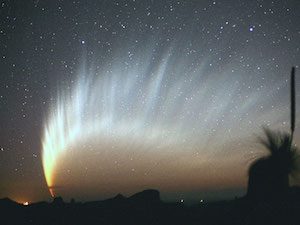Comets

Throughout history, comets have been viewed with fear and fascination, frequently attributed to the actions of celestial beings or as omens of death and destruction. When Westerners began learning about Aboriginal traditions in the early 1800s, they noted that the Aboriginal people viewed extraordinary or unusual natural events with great dread. The unexpected arrival of a bright comet often triggered fear and were associated with death, spirits, or omens – a view held by various cultures around the world.
Such views include those of the Tanganekald of South Australia who perceived comets as omens of sickness and death, the Mycoolon of Queensland who greeted comets with fear, the Kaurna of Adelaide who believed that the sun father, called Teendo Yerle, had a pair of evil celestial sisters who were “long” and probably represented comets, and the Euahlayi of New South Wales saw comets as evil spirits that drank the rain-clouds causing drought, with the cometary tail representing a large thirsty family that drew the river into the clouds. The Moporr clan of Victoria described a comet as Puurt Kuurnuuk – a great spirit, while the Gundidjmara of Victoria saw a comet as an omen that lots of people will die.
Aboriginal people in the Talbot District of Victoria likened comets (called “Koonk cutrine too”) to smoke, where “too” means “to smoke”. This is similar to a report from Cape York Peninsula, where an Aboriginal community saw a comet as the smoke of a campfire. Similarly, the Aboriginal people of Bentinck Island in the Gulf of Carpentaria called a comet burwaduwuru, which means “testicle with smoke”. A common view among Aboriginal communities of the Central Desert links comets to spears. A Pitjantjatjara man named Peter Kunari described comets as the manifestation of a being named Wurluru who lived in the sky and carried spears that he occasionally threw across the heavens (a possible reference to meteors?). A similar association is shared by the Kaitish. The Rainbow Serpent, a much-feared evil spirit found in the Dreamings of many Aboriginal groups, was sometimes associated with comets. Some speculate that the origins of the Rainbow Serpent lay in transits of Halley’s comet, which was seen every 76 years, reinforcing stories handed down by Kuku-Yalanji law-carriers and custodians of the Bloomfield River, Queensland.
In some Arrernte and Luritja communities, comets are spears thrown by an ancestral hero to make his wife obedient to him. To some Arrernte clans, a comet was also a sign that a person in a neighbouring community had died, usually because of infidelity, and pointed to the direction of the deceased. A similar description is given about the Karadjeri of coastal Western Australia, but is instead attributed to meteors.
Learn More
Blogs and News
- Comets triggered Aboriginal tales of doom (ABC Science)
- Comets, Comet, Comets (Aboriginal Astronomy Blog)
- The Historic “Great Comets”! (Aboriginal Astronomy Blog)
Published Research
- Hamacher, D.W. and Norris, R.P. (2011). Comets in Australian Aboriginal traditions. Journal of Astronomical History and Heritage, Vol. 14(1), pp. 31-40.
- Hamacher, D.W. (2014). Comet and Meteorite Traditions of Aboriginal Australians. Encyclopaedia of the History of Science, Technology, and Medicine in Non-Western Cultures, edited by Helaine Selin. Springer-Netherlands.
